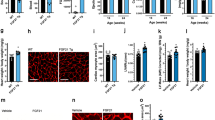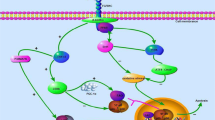Abstract
Connective tissue growth factor (CTGF/CCN2) is overexpressed in diabetes. Diabetic rats possess myocardial and cardiomyocyte hypertrophy. In a recent report, Wang and colleagues (Am J Physiol Cell Physiol. 2009 Jul 22. [Epub ahead of print]) show that CCN2 directly mediates cardiomyocyte hypertrophy as well as that induced by high glucose and fatty acid. CCN2 acted via the TrkA receptor. These data are the subject of this commentary, and emphasize that CCN2 may be an excellent target for therapy in diabetes.
Similar content being viewed by others
Avoid common mistakes on your manuscript.
Diabetes not only characterized by kidney failure but also can cause acute and chronic heart failure (diabetic cardiomyopathy) characterized by cardiac hypertrophy, apoptosis and excess accumulation of extracellular matrix (Karnik et al. 2007; Feuvray and Darmellah 2008). The proadhesive matricellular protein CCN2 is overexpressed in diabetes and can promote hypertrophy, apoptosis and fibrosis (Leask and Abraham 2006). Although CCN2 has been proposed as a target for drug therapy in diabetes (Mason 2009), whether CCN2 contributes to diabetic cardiomyopathy is unknown.
A recent report by Wang et al. (2009) showed that recombinant CCN2 could directly promote both apoptosis and hypertrophy in a cardiac myocyte cell line. Glucose and the fatty acid palmitate induced both apoptosis and hypertrophy in the same cell line. Glucose and the fatty acid palmitate induced CCN2 mRNA and protein, and siRNA against CCN2 significantly reduced the apoptosis and hypertrophy caused by these agents. Previously, it had been shown that CCN2 can bind and activate the TrkA receptor in human kidney mesangial cells (Wahab et al. 2005). Wang and colleagues (2009) found that pharmacological inhibition of TrkA blocked aspects of CCN2 activity.
That fatty acids can induce CCN2 lengthens the list of agents, which were initially believed to include only TGFβ, to promote CCN2 mRNA and protein expression (Blom et al. 2002). These data are significant as these strongly suggest that anti-CCN2 strategies may be useful in targeting several aspects of diabetes in addition to diabetic nephropathy and retinopathy (Mason 2009), and also suggest that CCN2 may contribute to additional pathologies induced by fatty acids including fatty liver disease (Paradis et al. 2001). Future efforts, no doubt, will be focused on expanding the scope of these studies to animal models and, ultimately, humans.
References
Blom IE, Goldschmeding R, Leask A (2002) Gene regulation of connective tissue growth factor: new targets for antifibrotic therapy? Matrix Biol 21(6):473–82
Feuvray D, Darmellah A (2008) Diabetes-related metabolic perturbations in cardiac myocyte. Diabetes Metab 34(Suppl 1):S3–9
Karnik AA, Fields AV, Shannon RP (2007) Diabetic cardiomyopathy. Curr Hypertens Rep 9(6):467–73
Leask A, Abraham DJ (2006) All in the CCN family: essential matricellular signaling modulators emerge from the bunker. J Cell Sci 119(Pt 23):4803–10
Mason RM (2009) Connective tissue growth factor(CCN2), a pathogenic factor in diabetic nephropathy. What does it do? How does it do it? J Cell Commun Signal, Feb 14
Paradis V, Perlemuter G, Bonvoust F, Dargere D, Parfait B, Vidaud M, Conti M, Huet S, Ba N, Buffet C, Bedossa P (2001) High glucose and hyperinsulinemia stimulate connective tissue growth factor expression: a potential mechanism involved in progression to fibrosis in nonalcoholic steatohepatitis. Hepatology 34(4 Pt 1):738–44
Wahab NA, Weston BS, Mason RM (2005) Connective tissue growth factor CCN2 interacts with and activates the tyrosine kinase receptor TrkA. J Am Soc Nephrol 16(2):340–51
Wang XY, McLennan SV, Allen T, Tsoutsman T, Semsarian C, Twigg SM (2009) Adverse effects of high glucose and free fatty acid on cardiomyocytes are mediated by connective tissue growth factor. Am J Physiol Cell Physiol, Jul 22. [Epubahead of print]
Open Access
This article is distributed under the terms of the Creative Commons Attribution Noncommercial License which permits any noncommercial use, distribution, and reproduction in any medium, provided the original author(s) and source are credited.
Author information
Authors and Affiliations
Corresponding author
Rights and permissions
Open Access This is an open access article distributed under the terms of the Creative Commons Attribution Noncommercial License (https://creativecommons.org/licenses/by-nc/2.0), which permits any noncommercial use, distribution, and reproduction in any medium, provided the original author(s) and source are credited.
About this article
Cite this article
Leask, A. Getting to the heart of the matter: CCN2 plays a role in cardiomyocyte hypertrophy. J. Cell Commun. Signal. 4, 73–74 (2010). https://doi.org/10.1007/s12079-009-0061-7
Received:
Accepted:
Published:
Issue Date:
DOI: https://doi.org/10.1007/s12079-009-0061-7




